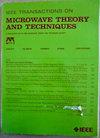DoA Estimation of Nonuniform Noise Sources via Off-Grid SBL in a Noncooperative Mode Using a Single RF Link
IF 4.1
1区 工程技术
Q2 ENGINEERING, ELECTRICAL & ELECTRONIC
IEEE Transactions on Microwave Theory and Techniques
Pub Date : 2024-10-01
DOI:10.1109/TMTT.2024.3464694
引用次数: 0
Abstract
With the advancement of integrated sensing and communication (ISAC) technologies, integrating sensing capabilities to commercial-off-the-shelf (COTS) communication devices has been at the forefront of research. Typically, these systems utilize antenna arrays configured across multiple radio frequency (RF) links to capture channel parameters such as direction of arrival (DoA). However, this architecture requires equipping each antenna with an independent RF link, increasing complexity and cost. Additionally, deploying sensing systems necessitates precalibration of the RF links to achieve the desired performance, further laboring deployment. To address these challenges, we design a switched antenna array (SAA) that can time-division activate each antenna within the coherence time on a single RF link, thus simulating a multi-RF links platform for accurate DoA estimation. Subsequently, a switching strategy is developed, and a matching algorithm based on random forest is introduced to tackle the issue that signals from different antennas exported from the single RF link cannot be differentiated due to the noncooperative mode between the SAA and the receiver. Additionally, addressing the impact of carrier frequency offset (CFO) caused by transceiver asynchrony on DoA estimation in the SAA system, we compensate for CFO and model its residuals as nonuniform noise. We introduce an off-grid DoA estimation algorithm based on sparse Bayesian learning (SBL), treating noise as its hyperparameter, and apply the expectation maximization (EM) and inverse iteration algorithms to reconstruct nonuniform noise model, aiming to overcome the impact of nonuniform noise on DoA estimation. We build prototype systems and conduct field trials in real-world environments. The experimental results show that our system achieves 3.7° angle of arrival (AoA) and 3.9° elevation of arrival (EoA) median estimation errors by utilizing only a single RF link without the need to perform a precalibration of the links and any modification of the COTS receiver settings.求助全文
约1分钟内获得全文
求助全文
来源期刊

IEEE Transactions on Microwave Theory and Techniques
工程技术-工程:电子与电气
CiteScore
8.60
自引率
18.60%
发文量
486
审稿时长
6 months
期刊介绍:
The IEEE Transactions on Microwave Theory and Techniques focuses on that part of engineering and theory associated with microwave/millimeter-wave components, devices, circuits, and systems involving the generation, modulation, demodulation, control, transmission, and detection of microwave signals. This includes scientific, technical, and industrial, activities. Microwave theory and techniques relates to electromagnetic waves usually in the frequency region between a few MHz and a THz; other spectral regions and wave types are included within the scope of the Society whenever basic microwave theory and techniques can yield useful results. Generally, this occurs in the theory of wave propagation in structures with dimensions comparable to a wavelength, and in the related techniques for analysis and design.
 求助内容:
求助内容: 应助结果提醒方式:
应助结果提醒方式:


